
The Best of Everything
Encyclopedia Entry • Films Main
Sadie McKee
1934

Critics' Reviews • Our Reviews • Movie Posters • Lobby Cards • Misc. Images
Click here to see photos from the film.
US release: 5/9/34.
VHS release: 12/5/90. DVD release: 2/12/08 as part of the Joan Crawford Collection, Vol. 2 3/3/17 on demand from Warner Archive Collection Blu-ray release: 3/25/25 Cast: Joan Crawford (as "Sadie McKee"), Gene Raymond, Franchot Tone, Edward Arnold, Esther Ralston, Earl Oxford, Jean Dixon, Leo Carrillo, Akim Tamiroff, Zelda Sears, Helen Ware, Helen Freeman, Leo G. Carroll. Cafe entertainers: Gene Austin, Candy, and Coco. Credits: Based on the 1933 story "Pretty Sadie McKee" by Vina Delmar, which originally appeared in "Liberty" magazine. Screenplay: John Meehan. Producer: Lawrence Weingarten. Director: Clarence Brown. Camera: Oliver T. Marsh. Costumes: Adrian. Editor: Hugh Wynn. Sound: Douglas Shearer.
Plot Summary: MGM's Sadie McKee is a superb example of how the "committee" system of moviemaking in the 1930s could sometimes yield unexpected delights. It all begins when Sadie McKee (Joan Crawford) is brought to big bad old New York by glib vaudevillian Tommy (Gene Raymond), only to be unceremoniously dumped in favor of actress Dolly (Esther Ralston). Cast adrift, our Sadie lands a nightclub job, where she meets genially intoxicated millionaire Brennan (Edward Arnold). Accepting his drunken marriage proposal, Sadie must endure the slings and arrows of Brennan's friends and family, who consider her a gold-digger. Meanwhile, Sadie's former boss Michael (Franchot Tone), the one true love of her life, waits and waits and waits to see what's really on the girl's mind! And as a bonus, this is the film that introduced the peppy ditty "All I Do Is Dream of You". The labyrinth plotline of Sadie McKee is proof enough that more than one screenwriter had a hand in its creation: but instead of chaos, the film is irresistibly watchable, full of unexpected plot twists and marvelous little surprises. ~ Hal Erickson, All Movie Guide |
Mordaunt Hall in the New York Times (1934): Clarence Brown's direction of this film is studied and in its way effective but it scarcely improves the flow of the story. There are many static interludes, a great deal of talk, which is by no means as interesting as the producers evidently thought it to be. Miss Crawford assuredly does well by her part, but even so the incidents in which she appears often are hardly edifying. It is in fact an exasperating type of motion picture.
Marguerite Tazelaar in the New York Herald Tribune (1934): Mr. Brown has employed an emotional quality in his direction that both helps and hinders the picture. It helps in keeping the story an exciting, vivid, enkindled canvas. It hinders, in exaggerating its artifice, its confusion and its lack of logic....Miss Crawford seems a bit miscast in the role of girlish innocence, but she does a competent job with Sadie, and in certain of her scenes is genuinely moving.
Hollywood Reporter (1934): Swell picture...sure-fire audience...well-tailored for the talents of Miss Crawford.... the stuff the fans cry for...direction of Clarence Brown something to rave about...a humdinger for femme fans. |
If you've seen Sadie McKee and would like to share your review here, please e-mail me. Include a picture of yourself or avatar to accompany your review, as well as a star-rating (with 5 stars the best) and any of your favorite lines from the film.
|
he
Rating:
I agree with Blanche Hudson: Sadie McKee (1934) is still a pretty good picture! Per "Conversations with Joan," JC agreed with us! Some of my favorite reasons include: * Joan is at peak 1930s loveliness. That early scene where she turns around in the maid outfit always takes my breath away, no matter how many times I watch it. * I think the story line about Edward Albert---millionaire drunkard Brennan---and his alcoholism being treated seriously rather than just comically is good drama. I also love their bittersweet breakup scene, the one shown in Baby Jane. * Gene Raymond as Joan’s love interest is a louse for most of the movie, but his final scene with Joan is three-hanky stuff, perhaps one of Joan’s best scenes from this stage in her career. * Jean Dixon as Opal, Joan’s worldwise friend, is a fine addition to the cast. Ditto Esther Ralston as Dolly. * "All I Do Is Dream of You" by Nacio Herb Brown and Arthur Freed, the team behind “Singing in the Rain,” is a favorite ditty from a Joan flick. I am still humming this song a week or so after watching SM. *Sadie McKee is directed by Clarence Brown, a Joan favorite. The only scene that dragged a bit was “Old Pal." Good, just too long. The "cigarette in the pie" scene at the automat is short but hits hard, as SM was released during the depths of the Great Depression. * Zelda Sears as landlady Mrs. Craney is a hoot in her early scenes. Ditto for noted character actor Akim Tamiroff as the cafe owner. Leo G. Carroll, a noted character actor, is Brennan's valet and enabler in his first film role.
At 93 min, SM zips along. The right balance of drama and levity. Joan looks great. The musical interludes are enjoyable. Blanche nailed it!
Rating:
Darling, you're just not very lucky. --- Sadie McKee to boyfriend Tommy.
Tommy's ongoing "unluckiness" is what propels and permeates Sadie McKee. The low-life Tommy (Gene Raymond) steals from his company and is fired. When his loyal servant girlfriend Sadie (Joan) hears higher-ups at her table (including lawyer Michael [Franchot Tone], a childhood friend) discussing his thievery and lack of American values, she pitches a public fit and then hops the train that Tommy's on for NYC (though he's neither expecting nor particularly wanting her to come with him).
Once in NYC, Tommy and Sadie run into the caustic and world-weary Opal (Jean Dixon), who guides them to her cheap boarding-house (and then later becomes a constant companion to Sadie, up until the very surprising final roommate situation in the last scene!) The weak-willed Tommy is quickly side-tracked by the semi-talented chanteuse Dolly Merrick (Esther Ralston) hanging around outside the community bathroom and he runs off with her, despite his appointment to marry Sadie at noon that day.
It's 1934, in the middle of the Great Depression---How is Sadie to survive?! There's a great early scene where a very hungry Sadie goes into a diner, buys only a 5-cent coffee, and is about to steal a leftover piece of pie from a fellow diner... until he puts his cigarette out in it. Her dismay is palpable.
Friend Opal gets Sadie a job as a dancer at her night-club, where a scantily clad Sadie is manhandled by obnoxious customers, until the drunken millionaire Jack Brennan (Edward Arnold) rescues her. Lawyer Michael, who once helped get Tommy fired for stealing back home, is an associate of Brennan's---and Michael is now highly suspicious of Sadie's intentions, though he was once in love with her while they were growing up. Brennan, however, is entranced with Sadie: Her mother is a cook, his mother was a cook, etc. He ignores Michael's admonitions and marries her. But just what is Sadie up to? Does she marry him for the money? Just to spite Michael? Because of both the money and a sincere desire to take care of Brennan? (They do seem to actually like each other.) At any rate, she can't go home again, so she's forced to play the hand dealt her.
In a way, Sadie McKee is a variation on a theme we saw in Possessed '31: A poor, simple girl must make her way in a wealthy, complicated world, and she's often mistrusted by her new associates, until she can prove herself to be a true "thoroughbred." (Annoyingly: In the very opening scene of Sadie, her rich boss sees her walking toward his car and proclaims to his companions that she's a "thoroughbred"---Let us find that out for ourselves, please!)
Director Clarence Brown (who also directed Possessed, Letty Lynton, Chained, and Gorgeous Hussy) takes full advantage of Joan's beauty, with a multitude of medium close-ups and close-ups that reveal both her subtle facial expressions (especially in her loving scenes with Tommy and her mildly repulsed scenes with Brennan), as well as her many gorgeous wardrobe changes. A couple of his quirky, interesting touches include the pie scene mentioned above, plus a funny scene in the nightclub where the sodden, nodding-out Brennan has kept Sadie, Michael, and the house band up long past closing time. The band (Gene Austin and Coco and Candy in their film debut) initially play a smokin'-fast rendition of "Old Pal"---only to have Brennan wake up briefly and say, "Now play something hot." (By the very end of the night, the tired band can only offer up a dirge-like version of the song.)
While Joan's acting is very good here, I do have a couple of small quibbles: Joan made this film when she was around 30 (if you give the birth year of 1905 or 1906 credence, which I do)---and a 30-year-old servant "girl" is a bit too old to be throwing a fit in front of her boss's family and running off with her hapless sometime beau to NYC. And then there's the fact that Joan's accent comes and goes: She speaks perfectly good English in the opening servant scene at home, but within 10 days of living in NYC, she's all of a sudden taken on the cadences of a gangster's moll! Once she's married, her accent becomes "vedy proper," only to slip back to "gangsta" when she's confronting Michael. Joan's slippery accents are the only flaw in a largely successful overall performance.
As for the co-players: Gene Raymond as Tommy: Perfect as the feckless, weak pretty-boy. His warbling of "All I Do Is Dream of You" is a recurring song of the film. His closeups with Joan early and late in the film are beautiful, and their interactions are touching, despite his callow unworthiness. Franchot Tone as Michael: Tone, to me, is usually, regardless of the film, obviously ACTING. "Look---I'm acting jolly!" "Look---I'm acting like a down-to-earth guy!" "Look---I'm acting stern!" In this film, he's also saddled with the thankless task of being the Superego character who's constantly lecturing Sadie on how to behave. Edward Arnold as Jack Brennan: A primarily kind and good-natured drunk, with a dollop of actual violence. (According to the AFI Sadie page, veteran actor Arnold said in 1948 that this was his favorite role.) Jean Dixon as Opal: Sadie's hard-boiled sidekick is blatantly out for herself, but she's also a good friend to Sadie, as well as serving as a warning to viewers of what Sadie might possibly become. Esther Ralston as Dolly Merrick: Just-right as the insouciant semi-talented club chanteuse who's not really bad---she just doesn't give a damn. Like Opal, she's just out to survive in a tough world.
Brown oversees a quick-paced, interesting film that's well-acted by Joan and the other players. Along with Dancing Lady and Chained, it's one of the best of her mid-'30s (1933 to 1936) films.
Rating:
everything, which is perhaps my 1 slight gripe with this film and of which I'll explain later.
Sadie McKee
is a tale of the title
character (played by Miss Crawford, of course) and 3 very different
relationships with 3 suitors. One is her long-term beau (Gene Raymond),
one is a rich but constant alcoholic whom Sadie manages to get involved
with almost by accident (Edward Arnold), and one
is Joan's own real-life future upper-class beau, who has obviously been
stuck on Sadie for a long time. (That gentleman is, of course, Franchot
Tone, husband #2 of Miss Crawford, and this their third film pairing
together.)
What I like about the character of Sadie McKee is that she's very likeable and a character you can root for. Along the course of the film, you witness as our strong-willed heroine experiences the twist and turns of love and life, and is someone who is quite willing to sacrifice her own happiness, if it means that the others in her life are better people for it as result. At the same time, you can't help but almost shout at the screen when Sadie's stubbornness and sometimes poor judgement in men come into play. Just like you would when you see a friend making bad choices and you want to step in and help---so again, relatable . Miss Crawford, as well as being an acting knockout with her effortless performance as Sadie, also looks like a knockout. The costume design for all stages of Sadie's life during the film were spot on, and it's simply 30's glamour and style at its best. Joan, too, looks so beautiful here that even in a maid's outfit, she looks sensational. My only minor gripe with Sadie McKee is the ending. Without giving too much away, the film ends too abruptly without giving the audience much knowledge of what Sadie is actually doing in the film's conclusion. Perhaps it was a conscious choice to allow audiences to decide for themselves, but still, it irritates me anyway! At least we DO end up with a clear conclusion of which man Sadie's heart would end up with by the time "The End" appears on the screen... All in all, Sadie McKee is pure 1930's MGM film making at its best. A must-watch!
Rating:
A fatal flaw in romantic moviemaking is the glaring lack of sincerity of the craftmanship. Too often -- and the filmic repertoire of Jennifer Lopez and Sarah Jessica reek of it -- the genre is manipulated, or geared even, toward star vehicle commerciality. The art of film itself becomes a commodity in the proceedings. That latter aspect of moviemaking was decidedly a contrived cog in the MGM machine back in the 1930s, yet Sadie McKee is one of those lost rare creations that deftly exhibits the star power of its cast while also striking with a certain warmth. When spirited maid Sadie McKee
(played by a very fresh-faced Joan Crawford) overhears her snobby
aristocrat employers badmouth her boyfriend, she verbally puts them in
their place and denounces her job. Along with her aspiring vaudevillian
lover Tommy (a very charming Gene Raymond), she relocates to New York,
where after sharing a few genuinely tender interludes with Raymond,
she finds herself jilted for a sultrier actress. From here the film
navigates Sadie through many situational contrasts; from mingling with
nightlife glitterati by means of earning a keep to accepting a proposal
of marriage from a drunkard suitor, to gaining the affections of her
ultimate true love (Crawford's future second husband, Franchot Tone),
Sadie has blossomed from a spiritually impoverished girl into a
liberated and wordly woman by the time the credits have rolled.
Conclusively the ending here seems intent on insinuating something more
emotionally uplifting than merely feel-good entertainment. Sadie McKee explores its themes (social class, alcoholism, true love) in cheap melodramatic fashion, but the quality of dialogue renders endearment from many of the scenes. The chemistry between Crawford and Raymond is especially affecting, perhaps in part due to the relative inexperience of both as first-rate moviestars. Together they create a tearfully bittersweet denouement with their character arc -- one that is twicefold more moving than we generally see in this genre today. As a whole, Sadie McKee was an intelligent choice of material for Crawford following her artistic breakthrough in Grand Hotel. The film has surprisingly aged well over the decades and undeniably more so than many classics of its day.
|

Above: US poster.
Below: France, Belgium, Sweden, unknown.

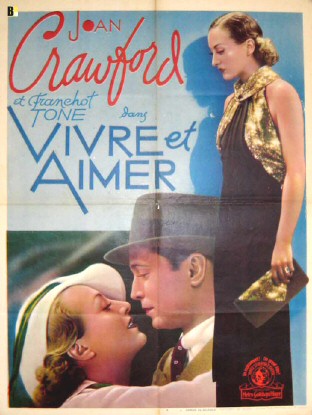


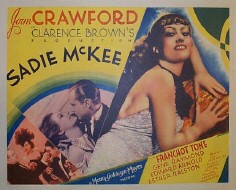

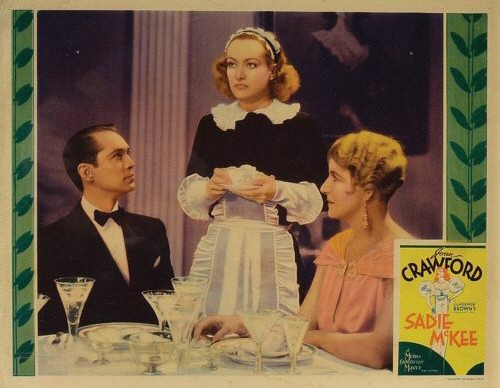

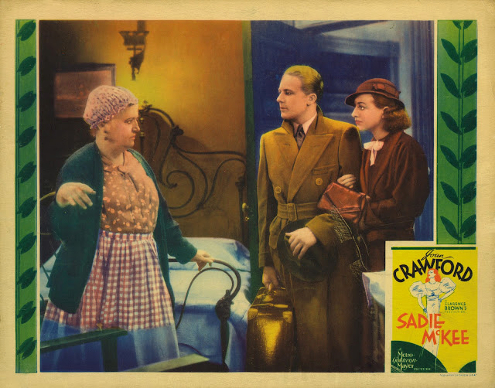
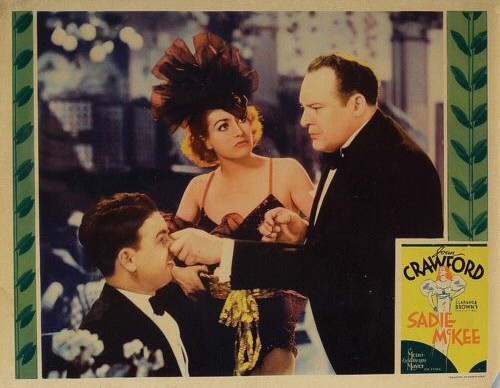
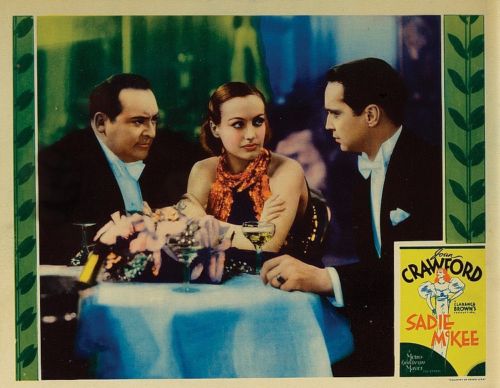

Above: US lobbies. Below: Italian Fotobusta lobby.

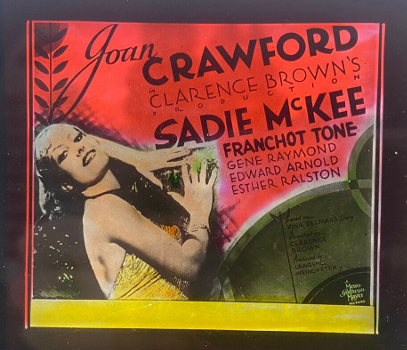

Above: US glass theater slide, US sheet music. Below: US pressbook.
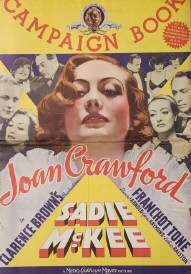
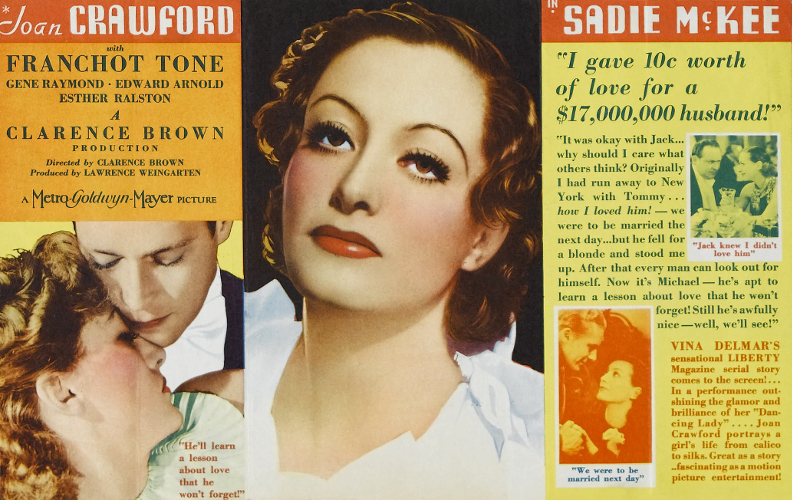
Below: US flyers.
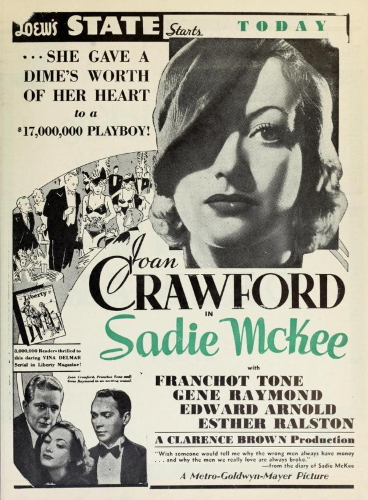
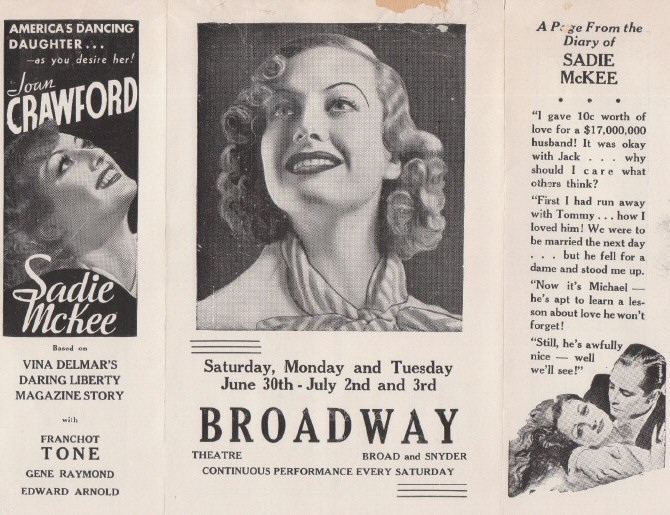
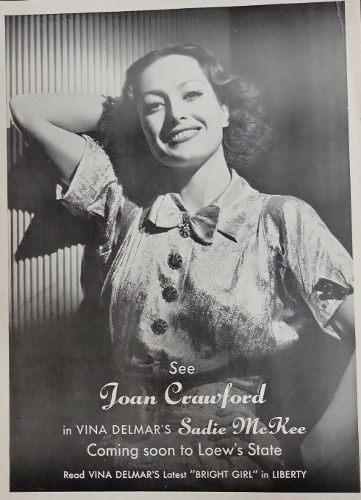


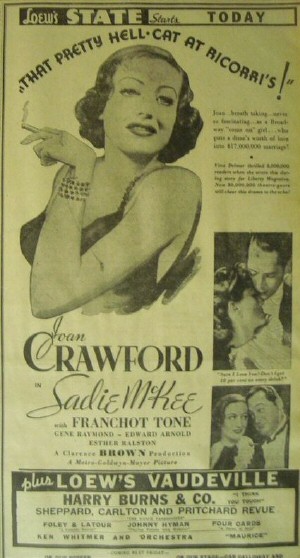
Above: US handbill, US trade ad, and US newspaper ad.


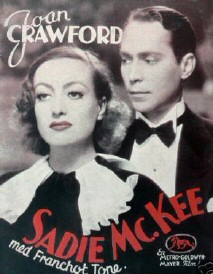

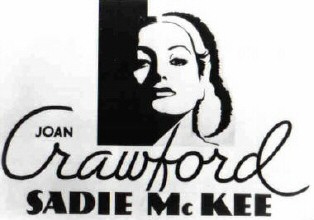
Above: Danish program, unknown herald, unknown publicity art.
Below: Two US window cards, Swedish program cover, and Spanish novelization.

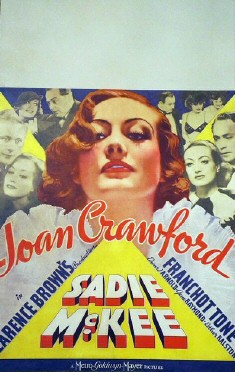
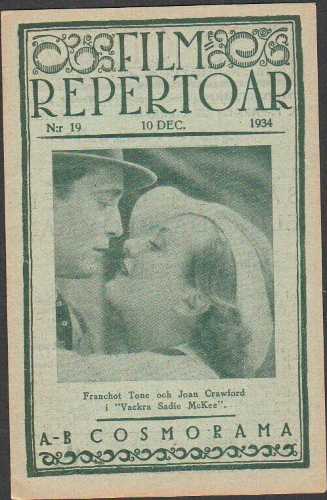

The Best of Everything